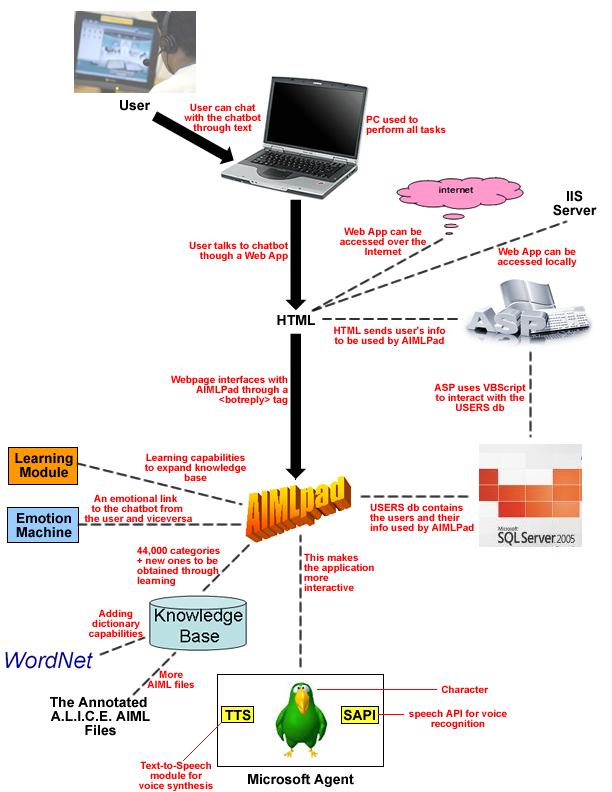
|
INTRODUCTION Our Capstone Design Project, entitled Conversational Bots for Smart Rooms, tries to integrate the concepts of learning and emotions to a chatbot system to address some of the inefficiencies found in these. For example, most chatbots have no capability of learning from conversations and maintaining its emotions in reaction to every previous scenario. These concepts are important, according to our vision, because the main goal of a chatbot should be to mimic real human conversations. More or less, we visualize this character (the chatbot) as a personalization of someone who has some knowledge about some things but is constantly learning everything that is said to it. We can see this as a kid who doesn’t know enough but with time his/her knowledge will expand and future conversations with that kid will hopefully be more solid. To achieve this general goal, there are different (and sometimes independent) tasks that we need to accomplish. First, it is important to realize that only a period of 6 months is given to the students to accomplish their projects. Because the broad topic of Artificial Intelligence and its fields were new to us, about half of that period has been used to research and learn about all the concepts involved in this project. We can divide the whole project in two parts: learning and emotions. Each part will be performed mainly by a single student, but both students will have to interact constantly to design interface for integration of both parts. When this period expires, the goal is to have implemented both parts and integrate their functionality. Now, let’s see what the main goals are for the learning aspect. LEARNING The learning aspect of this project has the main objective of giving the chatbot the capability of learning new facts and expanding its knowledge base. We as humans possess this characteristic since the moment we got into this world. Nowadays, there are so many implementations of chatbot systems, but only a few (if any) can maintain a coherent and convincing conversation like any of us would in real life. Some of the key aspects to maintaining such conversations are: a) learning from conversations, b) showing emotions that vary according to everything the bot goes through while conversing, c) keeping track of the topic and goal of the conversation, d) having the bot ask the questions, e) having a huge knowledge base with as facts and reasoning capability in as many topics as possible. Our work tackles points a and b: integrating and interfacing learning and emotion. Another reason for the lack of good conversations overall is the fact that many elements of the human being need to be considered besides just simply having a huge knowledge base. These elements are drawn from across many areas of study, such as philosophy, cognitive science, complex algorithms, and artificial intelligence. It is necessary to understand how the human mind really works in order to simulate a reaction to particular scenarios. Because of all this complexity and lack of time, we look for simple and foundational ways to integrate the concept of learning in our chatbot as defined below. As the baseline system for our chatbot we combine A.L.I.C.E. (alicebot.org) is programmed in AIML (Artificial Intelligence Mark-up Language), which is the mark-up language used to maintain knowledge of the bot (memory) and opencyg as an ontology (reasoning capability). Within the capstone project we will implement a learning method within this baseline system in order to enable the bot to learn through conversation. The goals to be accomplished for our Capstone Design Project based on learning are: EMOTIONS The project emotional conversational bots will cover various parts. Emotion is going to be integrated within an Emotion Module that is going to be integrated within a conversational system (chatbox) that is programmed through a web interface. Modeling Emotion a. Program and simulate Doerner’s emotional model using the following three parameters: b. Define a reasonable mapping from these continuous states to discrete emotional states which are c. Understand which parameters can be received by the chatbot in order to update current model of d. Program a module to update emotions in part (a) e. Interface with conversational learning chatbot. f. Document project in such a way to allow next group to continue your work. Using the original Doerner model, understand and document how an overall goal can be maintained
|
